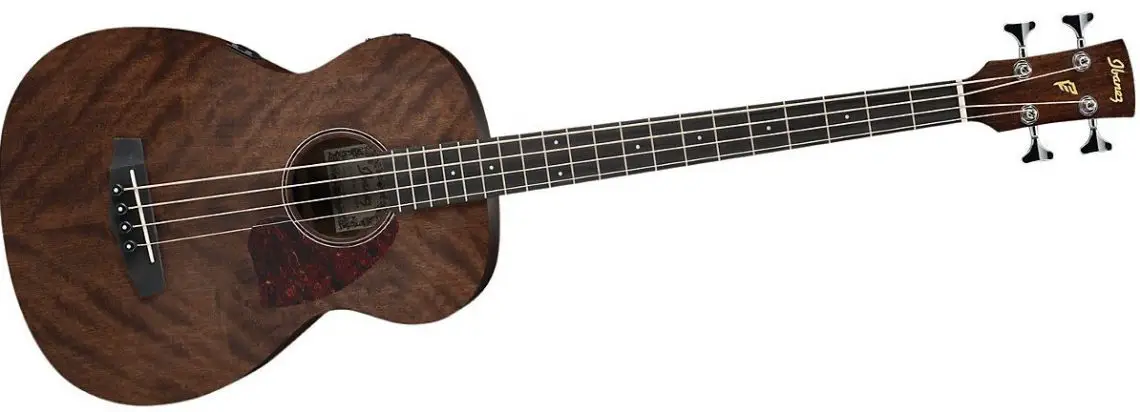If you are looking for a good-looking, well-made fretted acoustic bass guitar, you won’t have to search too hard. There are tons of affordable, high-quality instruments on the market, but that doesn’t mean you should just buy any old bass guitar.
You want to make sure that a particular bass has all the features that will meet your playing style. But, do you even know all the different features that are available on today’s acoustic bass guitars?
Here are a few tips on what to look for when you are purchasing a fretted acoustic, and a few reviews to help you start shopping.
Do Your Research
Know everything you need to know about the instrument before buying it. After being a musician for over thirty years, I have learned that impulsivity when it comes to buying your equipment is a bad idea.
You first need to consider how you will be using your instrument, where you will be playing it, what your budget is, and what features you need for your type of playing.
Once you have answers for all of these questions, then you can start your research. Online product reviews will give you a wealth of information that it is hard to know otherwise.
There is nothing like actual feedback from other musicians to know if you are getting a stellar instrument or a dud. It will be easy to weed out bass guitars if they do not fit your criteria, or if they get a bad review, and you will be able to quickly narrow down your search to a few candidates.
At this point, you need to visit a music store and try a few of these bass guitars out. There is nothing like actually playing the instrument to know whether or not it will work for you. You can decide if you like the tone and the pickups, if the string spacing is too wide, and if it just feels good to play.
If it is something you aren’t completely comfortable with, it is not going to be fun to play and it could hinder your performance either in the studio or onstage. It is always a good idea to look at the neck, fretwork, and finish to assess the quality of the instrument.
If you can, it is not a bad idea to play a higher end instrument to get an idea of what a really high-quality bass guitar is like, so you can make comparisons to the bass guitars you are looking at in you price range.

Credit: Epiphone
Top Pick: Epiphone Zenith
Classy look, great sustain, and a well-defined attack with some bloom to its acoustic notes. A very playable and comfortable acoustic bass.
Fretboard
Frets are a standard part of most every guitar. They are not always considered important as it isn’t always possible to make them stand out with a wood pattern or inlay. However, they do play an important part in how you play and sound when you consider a guitar’s playability and tone. Here are a few things to keep in mind when checking out the fretboard.
Frets work by pressing down a string against it that lessens the length of the vibration to the distance between the bridge and the pressure point to control the pitch.
On pretty much every guitar, there is a semi-tone of equal temperament coming from the distance between the frets giving you robust sounding single notes and chords.
Frets do have limitations and qualities that are important to understand based on the order of the frets. When you have this understanding, you can learn to break out from those constrictions, such as using a whammy bar, playing slide, bending strings, or using other techniques.
Material
Frets are sometimes made of brass, stainless steel, but most often they are made of copper nickel-steel alloys or nickel-silver. You notes will be brighter and sharper with the harder and thicker materials, so stainless would be the top choice and soft nickel the last choice for this type of sound.
Nickel alloys are used a lot by manufacturers since it is easy and soft to work with. Your average guitarist is used to the nickel sound, so it is common for guitarists to not prefer guitars that use other metals.
Measurements
The playability of a guitar is affected by fret height and width. A fret wire measures between .078 to .110 at the top of the guitar and between .035 and .055 high.
If you are interested in string bending and creating clear notes with not a lot of pressure, you need to look for taller frets measuring .45 and up. This is also a great height for high-speed playing.
Short frets are great for fast picking and created softer-edged tones. Wider frets are also a possibility for those that prefer better intonation. These frets measure between.100 to .110, plus wider frets wear a lot slower letting them retain their sound longer.
If you are looking to buy a new guitar, checking the frets is important. Look straight down the guitar’s neck to see if the frets are in good shape.
If you notice that the frets have different heights, this could mean that they were improperly installed. This is a problem and a big red flag as the frets should look even and there shouldn’t be any wear or denting.
Wear
The wear on frets does affect the bass guitar’s playability. Frets get worn from having string that are constantly being pressed down on them. They can also get depressions from bending, and the overall fret height can be lowered from being used.
Wear can also cause buzzing to start at the points on the fretboard that are worn. You can get these issues fixed by having the frets leveled and dressed, or you can have the fret replaced. This can get expensive, so only do it if necessary.
It is not uncommon for a fret wire to get sharp, or protrude on the side of the guitar’s neck. This can be pretty rough on your fingers, and it is telling you that your fretboard has dried out and shrunk from being kept in a place without proper humidity.
You can use lemon oil to prevent this from happening, plus being very careful where you store your guitars in the future will help tremendously.
Frets can influence your playing depending on your technique, musical taste, and how much wear the fretboard has. If you have a lot of resistance problems, you may need larger frets.
If you are having problems with buzzing or the notes sound off, your frets may be too low. Having problems with your intonation may mean your frets are too high. If you need to, raise your guitar’s action to try and fix the problem before you replace the fret.
Loose frets can happen from the fretboard becoming dry, or even jarred while you are playing it. A fret can even become loose while you are moving it during a gig.
This can be blamed on the wear of the fretboard. If the fret is just loose, it can usually be reseated into the slot, and the gaps can be filled between the fret ends and the binding.
Fanned Fret
Fanned frets can be used to get precise tuning and deep bass sounds. The frets are fanned out on the fingerboard at an angle to provide more length for the lower strings and less length for the higher strings.
Even though they may seem like something new, fanned frets have been around since the 16th century.
Build Design and Quality
Neck
One of the first things to examine on a potential acoustic bass guitar is the neck. You should ask yourself if it fits well in your hand, or if the fingerboard is too wide or narrow for your hand.
Are you having trouble trying to fret the notes or is it easy? Even if you are just a beginner, or even don’t know how to play, if the bass guitar does not feel right to you, then it probably isn’t. That isn’t something that is going to get better. If you are sure it is set up correctly, then this is not the instrument for you.
One other tip is to make sure you try playing the instrument both standing up and sitting down. Once the bass is strapped on, let go of it with your hands. The neck is too heavy if it slides down with the neck pointing to the ground.
A heavy neck on a bass guitar is still playable, but it will just make you tired faster because the hand that is fretting will be supporting the neck. Some guitar body shapes also might not feel comfortable sitting on your lap, so it is always a good idea to try other instruments.
Next, check for dead spots and buzzing by playing all the notes on each fret, plus all the open strings. If you can’t play these notes, it is always a good idea to bring along a friend that can.
If you hear any buzzing from open strings, but it disappears when you hold that string down, there is more than likely a nut that is cut too deep and needs to be replaced. A bad setup can cause a buzzing fret, so that can be fixed pretty easily, but if they are caused by a warped neck or bad fretwork, that can be a lot more expensive to fix.
You can tell a neck is warped if it is forming an “s” shape where the frets in either the lower or upper section of the neck are touching the frets, and the opposite side doesn’t. A bass string that is at full tension will form a completely straight line.
When you press down on the heaviest string so that it is touching the first and last frets at the same time, you should notice that the string will not touch the area in between the first and last frets as the neck will have a slight curve to it.
If you have too much space between the frets and the string, there is too much relief in the neck and it needs to have the truss rod tightened. If the string touches all the frets, your neck may still be straight, but it could be bowed causing the lower frets to buzz, and that means the truss rod needs to be loosened.
Body Construction
The neck pocket is the area where the body and the neck are attached. If it is a bolt-on neck, the neck should fit tightly in the pocket, and there should be very little to no space between them.
If you can slide anything thicker than a card in between the body and neck, look for another bass guitar. If you have a neck pocket gap, it will decrease the instruments sustain and harmonic overtones creating a lifeless and dull tone.
Finish
When you are checking out the finish, make sure to look for dimples, bubbles, and other defects in the paint job.
Just because the paint job is bad doesn’t mean that the bass guitar won’t play well or sound fine, but that type of lack of detail can indicate that the construction was overall done haphazardly.
Woods
When considering a guitar, the type of wood that it is created from is a big consideration. You will find the least expensive bass guitars are often made with a “butcher block” type of plywood, or a mixture of wood parts that are heavily sanded, glued together, and then painted over with a single veneer and heavy finish.
You can tell from the manufacturer specs if it has either a one-, two- or three-piece body. Terms like “wood” body or “solid” body can also be misleading.
It is getting harder to tell if a guitar has plywood construction, but you can often tell when you are looking at the finish from a bunch of different angles. Another sign is an uneven surface that is separated with straight lines that are indicative of various wood pieces that were glued together.
Hardware
Other important areas to look at are the tuners, pickups, bridge, controls, control plate/pickguard, and the string trees to make sure they are attached correctly and aligned properly. None of the screws should be stripped or inserted at an odd angle.
You can also adjust the tuning pegs to test how they feel. They should only have slight resistance, but otherwise turn smoothly. If the tuning pegs are either too loose or too stiff, the bass guitar will hard to tune correctly.
Also, pull on the strings near the bridge and nut lightly, the strings should stay in place. If they pop out at the nut, the guitar is not strung right, which is easy to fix, or the nut is too shallow, which can be expensive to fix.
If you see that the strings pull at near the bridge, that means the bridge saddles are loose, or they are cut too shallow. If you see anything of these issues, look at another instrument.
You should never buy a bass guitar that has strings that pull out of place. Also, check all the knobs to make sure they turn smoothly with little resistance, and the switches should firmly click and set when you move them.
The Competition
After hours of testing and research, here's the final competition.
| Instrument | Rating | Current Pricing |
|---|---|---|
Epiphone Zenith | The neck has good playability that gives you a good solid bass foundation |  |
PRS Paul Reed Smith SE Kingfisher Bass | Has a blistering bass line that rockers will love | |
Yamaha FD01S Solid Top Acoustic Guitar | This is a guitar that is great for both professional and intermediate players, but it is the ideal guitar for beginners |  |
Electric Acoustic Bass Guitar Blue | Comes with a striking cutaway design that allows easy access to the upper notes |  |
Ibanez PCBE12MHOPN | Has great style, tone, and playability at a very affordable price |  |
Fender CB-100CE | Has professional features that include mother of pearl acrylic rosette and a mahogany neck with a Jazz Bass profile |  |
Dean Acoustic-Electric Bass Cutaway 5 String | Very versatile acoustic bass guitar that is great for beginners |  |
Our Recommendation: Epiphone Zenith

Credit: Epiphone
The Epiphone Zenith has a transparent black finish with a rounded and chunky neck that is reminiscent of a Gibson..
The mahogany body is less semi-hollow and more chambered, and it is a little on the heavy side weighing in at ten pounds, but the extra weight does help give the guitar better balance.
The neck has a five piece sandwich of walnut and maple that gives it a classy look with its antique satin finish that is a normally a design choice used in high-end basses. Usually the neck has a thru-body, but the Zenith’s neck has no neck plate and five recessed screws
The neck does not have that uncomfortable reach that many acoustic bass guitars have as the acoustic-style bridge strings through the entire body giving it a lot more sustain that the average bolt-on bridge.
The Zenith sports a bit of a classy look with its tortoise-bound body edges and f-holes that work well with the transparent black finish.
The setup on the bass is pretty good. Normally basses that are off the rack have a higher nut than it needs to have. The Zenith has a nut that is cut to a playable level, and the 21 medium-jumbo frets are well-crowned. The neck has good playability that gives you a good solid bass foundation.
The onboard active electronics contain treble and cut/boost bass controls for each of the pickup, and a master blend and volume control, with a side-mounted jack plate that lets you either run two cables and two amps in a stereo or use summed-mono output.
There is also a thin Shadow Nano-Mag pickup at the end of the neck that has a little air-coil, silver-platinum shielding, and samarium-cobalt magnets.
The Nano-Flex is the second pickup that is an under-saddle piezo that is really a 7-layer, low impedance element that can sense vibrations in the body and the strings.
The Zenith has great sustain, and a well-defined attack with some bloom to its acoustic notes. Its bass mixes well with acoustic guitars, and you can get a thump while maintaining a lot of sustain when you boost the bass control a little and roll off some of the treble.
You can get a little more definition to your sound if you dial in a little of the magnetic pickup. You will hear a clear clack of the strings on the fret when you release a note, and there is a bit of murkiness in the midrange, so it may be necessary to boost the midrange some on your amp.
The bass heading is feedback resistant, even with higher volumes. This is definitely a very playable and comfortable acoustic bass guitar that is priced in the mid $700s.
Pros
Has a great wide-range tone
Has a beautiful, thick, clean jazz tone
Plays well with perfect intonation
Cons
None
Other Products to Consider:
PRS Paul Reed Smith SE Kingfisher Bass

Credit: PRS Guitars
The PRS Paul Reed Smith SE Kingfisher uses a standard single coil bass platform and when you add PRS’s finish, fit, and attention to detail, you have a modern look to a classic guitar.
The Kingfisher pickups are very focused and punchy, and that allows you to have a low to mid focus on the blues line with an eloquent high end that is full of harmonics and a sweet top end sound. It also has a blistering bass line that rockers will love.
The Kingfisher has a swamp ash body with a modern neck that has great sustain and a balanced tone. The maple and walnut neck was painstakingly designed with a 34-inch scale length neck that is incredibly comfortable for both new and longtime bass players alike.
It has a 24 fret Rosewood fretboard with birds, two PRS–designed, proprietary humbucking pickups, Hipshot tuners and bridge with thru-body stringing, rear mounted controls, and an SE gigbag.
The modern bridge lets you choose the string through the body or the bridge which creates a lot more tonal possibilities.
Pros
Good solid sound
It is beautiful and plays easily
Fast and punchy and has great mids
Cons
Lacks power
Yamaha FD01S Solid Top Acoustic Guitar

Credit: Yamaha Corporation
The Yamaha FD01S has superb projection and tone, and it is a solid-top guitar. This is a guitar that is great for both professional and intermediate players, but it is the ideal guitar for beginners.
It is a very affordably priced bass guitar that has a solid spruce top with rosewood fingerboard and bridge bass guitar, plus it comes with a lifetime warranty. This guitar will definitely grow with you, so you can enjoy it for many, many years.
It comes with the Gigmaker Deluxe package that also includes a tuner, strap, protective gig bag, picks, replacement strings, and instructional DVD that covers all the basic for you like picking, tuning, common chords and changing strings.
The FD01S combines high-quality wood with a great tone and a very affordable price of $150.
Pros
Easy to play and get a clean sound from
Beautiful looking guitar, sounds great
Professional, nice quality guitar
Cons
Lacks the polish you expect from Yamaha
Electric Acoustic Bass Guitar Blue

Credit: Amazon.com
The Electric Acoustic Bass Guitar Blue Solid Wood Construction With Equalizer comes with a striking cutaway design that allows easy access to the upper notes. This is a great guitar for beginners and for all musical styles.
It is a full sized guitar that features a bass 4-band equalizer and a beautiful inlay. It is made with a mahogany back and sides and a rosewood fingerboard. It has a super thin neck that is comfortable to play, and it also comes with an adjustable truss rod.
The Electric Acoustic Bass Guitar has a Schaller Style die-cast chrome machine head and a natural high gloss finish. The Electric Acoustic Bass Guitar is available for under $100.
Pros
Sound great with or without an amp
Great price for a great looking instrument
Great feeling bass with awesome sound
Cons
Has an annoying pickguard
Ibanez PCBE12MHOPN 4-String Acoustic Bass Guitar

Credit: Amazon.com
The Ibanez PCBE12MHOPN 4-String Acoustic Bass Guitar follows the Ibanez guiding philosophy for its acoustic collection of “a modern approach to acoustic guitar tradition.”
It has great style, tone, and playability at a very affordable price. It is another one of Ibanez’s creatively inspired tools that is built to flourish in any musical situation.
It has a mahogany top, back, and sides with a maple fretboard and a rosewood bridge, plus it features a tortoiseshell tuning machine and a chrome die-cast tuner. The Ibanez PCBE12MHOPN is available in the mid $200 range.
Pros
Great tone and playability
Nice instrument for the price point
Above average tune
Bass sounds marvelous
Cons
Onboard picks are not good for recording
Fender CB-100CE Dreadnought Cutaway Acoustic-Electric Bass – Natural
The Fender CB-100CE Dreadnought Cutaway Acoustic-Electric Bass has a laminated mahogany back and sides with a laminated spruce top, plus scalloped X-Bracing and a Rosewood bridge with compensated saddle.
It is an inexpensive dreadnought cutaway acoustic bass that has professional features that include mother of pearl acrylic rosette and a mahogany neck with a Jazz Bass profile.
It also features a Fishman Isys Pickup System with Active On-Board Pre-Amp and Tuner, and a dual-action truss rod. The Fender CB-100CE Dreadnought Cutaway Acoustic Bass is available in the mid $300’s.
Pros
Excellent sound, great quality
Great tone amplified or not
Great workmanship, awesome sound
Cons
Has some glitches when it is delivered that you will have to fix
Dean Acoustic-Electric Bass Cutaway 5 String
The Dean EAB Acoustic-Electric Bass is an easy playing instrument with a deep full tone. This full-sized bass has a 34” neck that is a very versatile acoustic bass guitar that is great for beginners.
If you enjoy jamming in the living room, but still want to plug into an amplifier or some recording equipment you can with the Dean preamp feature. It also features a mahogany body with a rosewood bridge and fretboard, plus a spruce top and pearl dot inlays.
It has great playability and construction for an affordable price, with the cutaway giving you the ability to reach the higher register, and you can get a little more on the low end of the low B string.
Basses or guitars see the mahogany and spruce combination as a fairly common choice among the acoustic tonewoods. Mahogany is great for a large dynamic range, and ideal if you want to amplify every nuance, but still sounds fabulous when you lay into it.
The spruce allows you to highlight the treble and bass, plus it looks awesome with the satin-finish spruce contrasting with the deep brown mahogany.
The mahogany neck, rosewood fingerboard, and classic pearl dot inlays are great features along with the matching rosewood bridge, and Dean’s contemporary “sliver” shape. It is augmented with the celluloid rosette and body binding.
Other features include Dean’s die-cast tuners that guarantee you stay in tune, even when you are plugged in, and the onboard Dean preamp that gives you simple tone and volume controls, so you can choose your sound preferences. The Dean EAB Acoustic-Electric Bass is available in the mid $200 range.
The Dean EAB Acoustic-Electric Bass is available in the mid $200 range.
Pros
Really nice sound, great value
Has good fretboard playability
Nice finish, great sound
Cons
Uneven sound from low to the high strings
Source
http://www.premierguitar.com/articles/Understanding_Frets_and_Fret_Wear
https://www.ultimate-guitar.com/lessons/the_guide_to/cleaning_your_fretboard.html










Start the discussion at talk.hearthemusicplay.com